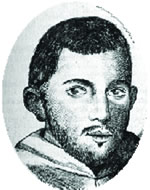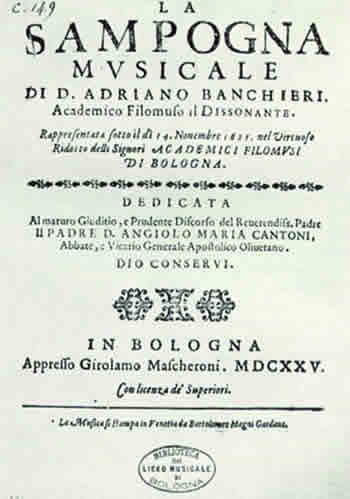A Musician in the Middle of the Ford
by Maria Chiara Mazzi
Adriano Banchieri, a monk and a musician, innovative and nostalgic.
Let us imagine Bologna between
the sixteenth and the beginning of the seventeenth century. The city, from the
musical and cultural points of view, is an international crossroad  (thanks in part to the University), a true source of ideas, of theoretical
discussions, of applied sciences.
(thanks in part to the University), a true source of ideas, of theoretical
discussions, of applied sciences.
Bologna is rich with academies,
associations created by nobility, usually hosted in private homes and visited by
men of culture who meet to compose poetry, discuss codes of honour, prepare
plays, play music, dance. These academies (we could almost compare them to the
cultural circles of today) had particular and strange names like the Academy of
the Anxious, of the Drowsy,  of the
Fervent, of the Dubious, of the Anxious, and eventually the Philharmonic Academy
(still active today). Among these, one in particular gains remarkable
importance. Called the Accademia dei Floridi (later called Dei Filomusi, it
converged in the middle of the seventeenth century with the Philharmonic
Academy), it was founded by the theoretical composer and man of letters
Adriano Banchieri in 1615 in the convent of San Michele in Bosco where Claudio
Monteverdi was a guest in 1620.
of the
Fervent, of the Dubious, of the Anxious, and eventually the Philharmonic Academy
(still active today). Among these, one in particular gains remarkable
importance. Called the Accademia dei Floridi (later called Dei Filomusi, it
converged in the middle of the seventeenth century with the Philharmonic
Academy), it was founded by the theoretical composer and man of letters
Adriano Banchieri in 1615 in the convent of San Michele in Bosco where Claudio
Monteverdi was a guest in 1620.
Unusual character, a typical exemple of
Bolognese eclectism,  Adriano Banchieri (or Camillo Scaligeri della Fratta or
Attabalippa del PerÓ, pseudonyms he used in his numerous publications) was born
in Bologna October 3, 1568, was baptized and given the name of Tommaso which
will later be changed to Adriano when he took holy benedictine orders in the
olivetan monastery of San Michele in Bosco. The scholar will remain in the
monastery until his death and will perform his activities as a composer, writer,
researcher, music theoretician (he is the one who introduced the use of vertical
bar lines which separate musical tempo in partitions).
Adriano Banchieri (or Camillo Scaligeri della Fratta or
Attabalippa del PerÓ, pseudonyms he used in his numerous publications) was born
in Bologna October 3, 1568, was baptized and given the name of Tommaso which
will later be changed to Adriano when he took holy benedictine orders in the
olivetan monastery of San Michele in Bosco. The scholar will remain in the
monastery until his death and will perform his activities as a composer, writer,
researcher, music theoretician (he is the one who introduced the use of vertical
bar lines which separate musical tempo in partitions).
His production
reflects this eclectism: man of letters fond of the vernacular (he wrote, with
the pseudonyms Camillo Scaligeri della Fratta and Attabalippa del PerÓ, comedies
in Bolognese and the successful Bertoldo, recounting the adventures of the
unlucky Cacasenno), but above all a musician, Banchieri reflects the times where
the old polyphonically composed music was replaced by the very new melodramas,
instrumental music, and public performance.
Brother Adriano is, on the
contrary, an uncertain nostalgic; he misses the times where music was intended
only for cultured connoisseurs, but he is unable to completely renounce new
opportunities. And so he writes madrigal cycles, an old form compared to
melodramas, but which uses dialects (and not only from Bologna) instead of the
noble Tuscanese. He publishes light-hearted songs, and makes fun of tradition by
including in his music the masks of the commedia dell'arte. In this sense, his
most original creativity is a madrigal drama, a composition for the initiated,
ignoring the vocal music of a soloist, using polyphony, but recounting of a
world profoundly linked to the popular roots of the carnival. A sort of
polyphonic theater with content and characters from the commedia dell'arte, at
the same time new and nostalgic, last expression of a world that would
soon definitely disappear.